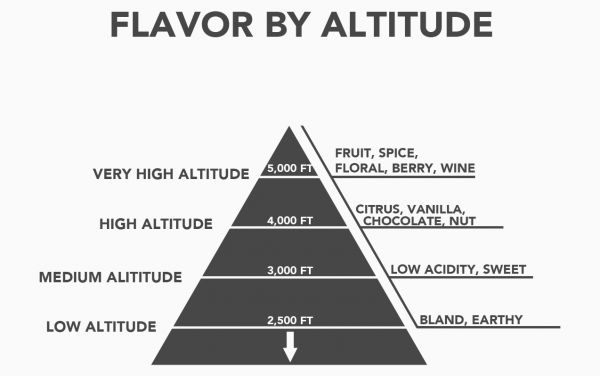You may be wondering what makes a coffee a specialty coffee. Is it the region? The variety? The rating? The species? Simply put, it’s all those things. But coffee is more than the sum of its parts. While we could fill a textbook with all of the factors that go in to determining the quality of coffee, today we will focus on only one, which also happens to be one of the biggest misconceptions related to coffee quality.
You have probably heard by now that Arabica coffee is generally considered to be high quality coffee. It is a fact that all of the best tasting coffees are Arabica. From smaller roasters to Starbucks to Folgers – everyone proudly touts that their coffee is 100% Arabica, but what does that really mean? Is the word “Arabica” the end all, be all of final beverage quality? The short answer is no, but we’ll talk a little bit about coffee species and what it means in terms of quality and flavor.
THE DIFFERENCE BETWEEN ARABICA AND ROBUSTA COFFEES
The coffee plant, coffea, is a genus that consists of about 100 species, but there are only two that are commonly referenced – arabica and robusta. The most significant difference in the species, which affects the physiology and flavor of the bean, is the elevation at which they are grown. Generally speaking, a higher elevation = a better tasting cup.

Credit: DT Coffee Club
Arabica coffee makes up about 75% of the world’s current coffee production. Arabica coffee grows at higher altitudes, producing a denser, richer bean with more concentrated flavors and sweetness. The beans are naturally more mild and aromatic with subtle and varied flavors.
Robusta is a resilient species grown at low altitudes. It tends to be bitter, earthy, and higher in caffeine content. The caffeine, which imparts those flavors, acts as a natural pesticide for the plant (necessary at lower elevations). It has only half the sugar content of Arabica coffee and double the caffeine content. Robusta is used by some coffee producers because the plants, being hardier and easier to grow, produce a cheaper bean. However, it is not common that you’ll find Robusta in many coffees except as a filler in inexpensive brands or as instant coffee.
SO WHY THE DISTINCTION?
Despite the association with Arabica beans as being of higher quality than Robusta, it is not always the case. Oftentimes, high end Robusta will taste just as good as low end Arabica.
Historically, Robusta beans were used as an alternative to non-coffee fillers used after the war. Any coffee that was 100% Arabica was thus labeled as such in order to justify the increased price, whether or not the flavor was actually any better. That’s it. So, while all the best coffees are Arabica, not all Arabica is suitable for specialty coffees and you should keep that in mind when shopping for coffee at the grocery store.
INDICATORS OF QUALITY
You may be wondering how you can be sure that you are buying a high quality coffee now that we’ve shattered the 100% Arabica illusion for you. Next time you are shopping for coffee, ask yourself some of these questions.
1. What are the flavor descriptors? Are they specific like “cane sugar” and “tart blackberry” or vague like “smooth” and “bold”? General terms may imply that either the coffee is of lower quality or the roaster didn’t take care to bring out the coffee’s unique characteristics.
2. How fresh is the coffee? Is the roast date clearly visible on the bag? Coffee that has been sitting on a shelf for weeks will never be as flavorful and delicious as freshly roasted coffee, regardless of how high end the beans once were.
3. Is it single origin? Is it seasonally available? At the farm level, quality and quantity have an inverse relationship. The highest quality lots in the world are not available year round or in large enough quantities for major roasters to use.
4. What is the roast degree? Is it very dark? Not that we have anything against darkly roasted coffees, but any roaster can produce roasty, smoky, and bold flavors with any coffee – whether it is of high or low quality. In fact, darkly roasting coffee began as a way to mask the flavor of Robusta beans in blends when specialty coffee first started gaining traction in the US and supply of high quality beans could not meet demand. Bringing out more complex flavors requires both high quality beans and attention to detail during the roasting process.
5. How large is the roastery? Is it a global brand or a small batch roaster? Unfortunately, quality can sometimes be sacrificed for the sake of quantity and consistency. When you are roasting 1 million pounds of coffee per week, it can be difficult to give the necessary time and care to every batch.
6. How much are the coffee beans? What is the price per ounce? Although supply and demand and creative marketing can have a huge influence on price, generally speaking, it is not likely that you’ll find a high quality coffee for less than $12 per 12oz bag.
While those are only a few factors that influence the quality of coffee, these questions may help guide you in your search for the best coffees.
Or, make it easy on yourself and sign up for one of our subscription services. We’ll send you high quality, freshly roasted specialty coffees delivered automatically. Sign up here.


